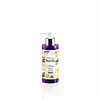What's inside
What's inside
 Key Ingredients
Key Ingredients

 Benefits
Benefits

 Concerns
Concerns

 Ingredients Side-by-side
Ingredients Side-by-side

Water
Skin ConditioningCetearyl Alcohol
EmollientBehentrimonium Methosulfate
Cetyl Esters
EmollientAmodimethicone
Argania Spinosa Kernel Oil
EmollientParfum
MaskingPhenoxyethanol
PreservativeCitric Acid
BufferingBehentrimonium Chloride
PreservativeTrideceth-6
EmulsifyingIsopropyl Alcohol
SolventCetrimonium Chloride
AntimicrobialSodium Hyaluronate
HumectantBenzyl Alcohol
PerfumingLinalool
PerfumingCoumarin
PerfumingLimonene
PerfumingHexyl Cinnamal
PerfumingCitronellol
PerfumingBenzyl Benzoate
AntimicrobialAmyl Cinnamal
PerfumingCitral
PerfumingGeraniol
PerfumingWater, Cetearyl Alcohol, Behentrimonium Methosulfate, Cetyl Esters, Amodimethicone, Argania Spinosa Kernel Oil, Parfum, Phenoxyethanol, Citric Acid, Behentrimonium Chloride, Trideceth-6, Isopropyl Alcohol, Cetrimonium Chloride, Sodium Hyaluronate, Benzyl Alcohol, Linalool, Coumarin, Limonene, Hexyl Cinnamal, Citronellol, Benzyl Benzoate, Amyl Cinnamal, Citral, Geraniol
Water
Skin ConditioningCetearyl Alcohol
EmollientCoco-Caprylate
EmollientPyrus Malus Seed Oil
EmollientTriticum Vulgare Germ Oil
EmollientPapaver Somniferum Seed Oil
EmollientBehentrimonium Methosulfate
Inulin
Skin ConditioningOctyldodecanol
EmollientHydrogenated Coco-Glycerides
EmollientHelianthus Annuus Seed Extract
Skin ConditioningAcacia Senegal Gum Extract
Linum Usitatissimum Seed Extract
PerfumingAlthaea Officinalis Root Extract
Skin ConditioningPrunus Amygdalus Dulcis Fruit Extract
Skin ConditioningXanthan Gum
EmulsifyingHydroxypropyltrimonium Hydrolyzed Corn Starch
Glycerin
HumectantTocopheryl Acetate
AntioxidantLactic Acid
BufferingSodium Benzoate
MaskingPotassium Sorbate
PreservativePhenoxyethanol
PreservativeBenzoic Acid
MaskingDehydroacetic Acid
PreservativeParfum
MaskingWater, Cetearyl Alcohol, Coco-Caprylate, Pyrus Malus Seed Oil, Triticum Vulgare Germ Oil, Papaver Somniferum Seed Oil, Behentrimonium Methosulfate, Inulin, Octyldodecanol, Hydrogenated Coco-Glycerides, Helianthus Annuus Seed Extract, Acacia Senegal Gum Extract, Linum Usitatissimum Seed Extract, Althaea Officinalis Root Extract, Prunus Amygdalus Dulcis Fruit Extract, Xanthan Gum, Hydroxypropyltrimonium Hydrolyzed Corn Starch, Glycerin, Tocopheryl Acetate, Lactic Acid, Sodium Benzoate, Potassium Sorbate, Phenoxyethanol, Benzoic Acid, Dehydroacetic Acid, Parfum
Ingredients Explained
These ingredients are found in both products.
Ingredients higher up in an ingredient list are typically present in a larger amount.
Behentrimonium Methosulfate is an ammonium salt. It is mainly used to prevent static in haircare products as a surfactant.
Surfactants have differing ends: one side is hydrophilic while the other end is hydrophobic.
Surfactants also help your cleansers remove pollutants more easily from the skin.
Learn more about Behentrimonium MethosulfateCetearyl alcohol is a mixture of two fatty alcohols: cetyl alcohol and stearyl alcohol. It is mainly used as an emulsifier. Emulsifiers help prevent the separation of oils and products. Due to its composition, it can also be used to thicken a product or help create foam.
Cetearyl alcohol is an emollient. Emollients help soothe and hydrate the skin by trapping moisture.
Studies show Cetearyl alcohol is non-toxic and non-irritating. The FDA allows products labeled "alcohol-free" to have fatty alcohols.
This ingredient is usually derived from plant oils such as palm, vegetable, or coconut oils. There is debate on whether this ingredient will cause acne.
Due to the fatty acid base, this ingredient may not be Malassezia folliculitis safe.
Learn more about Cetearyl AlcoholParfum is a catch-all term for an ingredient or more that is used to give a scent to products.
Also called "fragrance", this ingredient can be a blend of hundreds of chemicals or plant oils. This means every product with "fragrance" or "parfum" in the ingredients list is a different mixture.
For instance, Habanolide is a proprietary trade name for a specific aroma chemical. When used as a fragrance ingredient in cosmetics, most aroma chemicals fall under the broad labeling category of “FRAGRANCE” or “PARFUM” according to EU and US regulations.
The term 'parfum' or 'fragrance' is not regulated in many countries. In many cases, it is up to the brand to define this term.
For instance, many brands choose to label themselves as "fragrance-free" because they are not using synthetic fragrances. However, their products may still contain ingredients such as essential oils that are considered a fragrance by INCI standards.
One example is Calendula flower extract. Calendula is an essential oil that still imparts a scent or 'fragrance'.
Depending on the blend, the ingredients in the mixture can cause allergies and sensitivities on the skin. Some ingredients that are known EU allergens include linalool and citronellol.
Parfum can also be used to mask or cover an unpleasant scent.
The bottom line is: not all fragrances/parfum/ingredients are created equally. If you are worried about fragrances, we recommend taking a closer look at an ingredient. And of course, we always recommend speaking with a professional.
Learn more about ParfumPhenoxyethanol is a preservative that has germicide, antimicrobial, and aromatic properties. Studies show that phenoxyethanol can prevent microbial growth. By itself, it has a scent that is similar to that of a rose.
It's often used in formulations along with Caprylyl Glycol to preserve the shelf life of products.
Water. It's the most common cosmetic ingredient of all. You'll usually see it at the top of ingredient lists, meaning that it makes up the largest part of the product.
So why is it so popular? Water most often acts as a solvent - this means that it helps dissolve other ingredients into the formulation.
You'll also recognize water as that liquid we all need to stay alive. If you see this, drink a glass of water. Stay hydrated!
Learn more about Water